On May 29, 2018, DHS published a proposed rule to remove the International Entrepreneur Parole Program (IER). This was hardly unexpected.
Since January 25, 2017, when President Donald Trump issued the Border Security and Immigration Enforcement Improvements executive order, it has been clear that the Administration would seek to eliminate the IER as being an inappropriate use of DHS parole authority. In July 2017, DHS attempted to delay the effective date of the rule until March 14, 2018, while it developed its proposal to eliminate the rule. On December 1, 2017, the U.S. District Court for the District of Columbia in National Venture Capital Association v. Duke ruled that DHS would have to continue to accept IER applications. To date, DHS has received 13 applications and none of the applicants have been granted parole.
DHS has justified the removal of the IER on several grounds:
-
Parole authority is not appropriate for implementing a complicated program for entrepreneurs and business start-ups that would be best implemented by Congress;
-
Entrepreneurs should use existing legislative vehicles such as the E-2, E-5, or National Interest Waiver programs to the extent possible; and
-
DHS should not use its limited resources to implement a policy does not support Trump’s chief objective of protecting U.S. workers.
Despite the fact that no IER applications have been approved, DHS has proposed various options for the termination of the program. Its preferred option is to simply end parole on the effective date of the final rule. There are also proposed provisions for those who have pending applications. These individuals may withdraw their applications and have their fees returned or leave their applications in place and argue that they are entitled to discretionary parole even without the IER.
Elimination of the IER was set out in the DHS’ Spring 2018 Regulatory Agenda, which also included:
-
Establishing electronic registration for the Cap H-1B program;
-
Changing the focus of the H-1B program to the “best and brightest” and protecting the interests of U.S. workers;
-
Eliminating H-4 EADs;
-
Updating the USCIS fee schedule;
-
Modernizing the EB-5 Immigrant Investor Program;
-
Reforming Practical Training programs for students; and
-
Mandating more electronic filings.
Eliminating H-4 EADs is next up. That proposed new rule is expected in June 2018, followed by the Cap H-1B electronic registration rule in July 2018.



 />i
/>i

